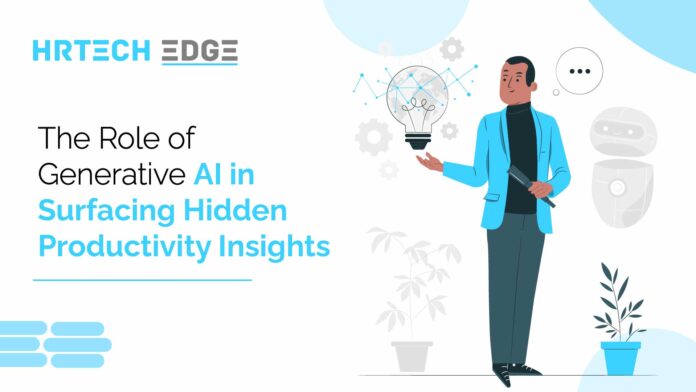A global enterprise has dashboards and metrics on employee performance charts, project timelines, and customer engagement scores. On paper, the data is helping, but leaders feel frustrated. Collaboration gaps remain hidden, and teams often work in silos. Despite all the reporting, there is no clarity on why productivity is slowing.
Generative AI tools process data, such as emails and chat logs, to workflow systems and CRM, and uncover patterns. For example, Generative AI can analyze conversations, bandwidth, and decision-making hierarchy to explain why bottlenecks occur. This shift matters because productivity insights emerge from interactions between people, processes, and technology.
This article will discuss the role of Gen AI in uncovering productivity insights.
Key Applications of Generative AI Tools for Productivity
Below are some key applications of Gen AI tools for productivity.
- Workflow Optimization
Generative AI analyzes workflows and identifies hidden bottlenecks in processes. For example, in a SaaS company, AI tools detect that customer onboarding delays stem from manual data entry. Based on this insight, you can automate tasks and accelerate time-to-value.
- Intelligent Communications
Generative AI can summarize discussions and even suggest the optimal attendees based on the agenda. In a consulting firm, AI-generated meeting summaries can save time, freeing them to focus on client strategy.
- Cross-Functional Collaboration Insights
Generative AI correlates patterns across different departments, revealing inefficiencies. For instance, in a manufacturing enterprise, AI-driven tools link production delays to misaligned procurement schedules, enabling the synchronization of the supply chain.
- Predictive Performance Monitoring
Generative AI forecasts potential productivity dips. For example, in a financial services firm, AI detects that compliance reviews take longer during quarter-end cycles, enabling managers to allocate additional resources.
- Employee Support
Generative AI processes unstructured data such as emails, policy documents, and project archives. In a professional services company, AI-driven tools can surface past project learnings to guide new proposals, cutting down research time and improving accuracy.
- Personalized Productivity
Along with team-level data, AI can also provide individual insights. For example, in an organization, Generative AI may recommend strategies for reps who spend excessive time on admin work, boosting their focus on high-value client interactions.
How to Implement Generative AI Tools to Uncover Productivity Insights
Below are the steps on how you can implement Gen AI for productivity insights.
- Start with Clear Objectives
Define what productivity means for you. Is it reducing project turnaround times, minimizing operational costs, or improving employee efficiency?
Example: A logistics firm set a goal to reduce shipment delays. By aligning the objective with Generative AI, the tool was configured to analyze route data, scheduling conflicts, and communication logs.
- Integrate Data Across Silos
To surface hidden insights, you need access to structured data (e.g., CRM, ERP) and unstructured data (e.g., emails, collaboration tools).
Example: An IT services company integrated project management software with client communication channels. With AI-driven tools analyzing both, they discovered that client escalations were directly linked to delayed internal approvals.
- Deploy AI in Pilot Projects First
Begin with smaller pilot projects that target a specific productivity challenge. This allows leaders to measure ROI, build trust, and then do a full-scale rollout.
Example: A consulting firm piloted Generative AI in proposal development. AI tools analyzed past winning proposals and client feedback, reducing drafting time. Once proven successful, the solution was scaled across other business functions.
- Simulate Scenarios with AI for Analysis
Leaders can use Generative AI to simulate outcomes or explain why productivity bottlenecks occur.
Example: In a financial services firm, AI tools generated multiple “what-if” scenarios for compliance reviews. Leaders could visualize how shifting resources or automating documentation impacted turnaround times.
- Embed AI into Daily Workflows
Embedding Generative AI into collaboration platforms ensures insights are delivered at the point of decision-making.
Example: A manufacturer embedded AI copilots into Microsoft Teams. Managers received real-time insights on team workload, upcoming deadlines, and potential resource conflicts.
- Train Teams and Build Trust in AI Outputs
Employees may resist relying on AI tools if they don’t understand how insights are generated. Training and transparent communication are critical for adoption.
Example: A healthcare technology provider conducted workshops showing how Generative AI highlights workflow inefficiencies. By demonstrating real use cases, they built confidence among managers and employees, leading to higher engagement with AI insights.
- Establish Governance and Compliance Standards
AI-powered insights involve sensitive workforce data. Strong governance frameworks are essential to ensure ethical use and privacy compliance.
Example: A banking firm implemented strict data access controls before rolling out Generative AI for productivity analytics.
- Measure ROI and Refine
Organizations need to measure improvements in efficiency, employee satisfaction, and cost savings to validate ROI. Feedback loops help refine models for better insights.
Example: A SaaS provider tracked metrics such as project delivery times, meeting hours saved, and employee engagement scores. They refined the AI model quarterly, ensuring sustained productivity gains.
Benefits of Generative AI Tools for Productivity Insights
Here are the key benefits of Generative AI for productivity insights.
- Turning Data Overload into Actionable Insights
Organizations collect vast amounts of data that often go unused. Generative AI can analyze the data to highlight patterns that might be overlooked.
Example: A professional services firm used AI tools to analyze project documentation, client emails, and timesheets. It found hidden inefficiencies in review cycles, cutting project delivery times.
- Predicting Bottlenecks Before They Happen
Traditional reporting shows what has already gone wrong. Generative AI goes further by predicting where productivity might dip next.
Example: In a logistics company, AI tools forecast delays during peak shipping periods. Managers reallocated resources based on the data, improving client satisfaction.
- Enhancing Cross-Functional Collaboration
By analyzing communication patterns and workflow overlaps, Generative AI helps break down silos across departments.
Example: A global manufacturer discovered through AI analysis that production delays were linked to procurement’s approval cycle. Once aligned, the overall lead time dropped.
- Stronger ROI on Investments
Many enterprises struggle to prove ROI from Gen AI investment. Generative AI enables leaders to understand the relationship between productivity improvements and business outcomes.
Example: A consulting firm measured a reduction in proposal preparation time after deploying Generative AI. It translated to closed deals.
Conclusion
Real power lies not just in the technology, but in how leaders choose to implement it. Those who adopt early will gain an edge in agility and market responsiveness. Start by piloting Generative AI where needed most, scale proven use cases, and build a culture of data-driven decision-making.
Paramita Patra is a content writer and strategist with over five years of experience in crafting articles, social media, and thought leadership content. Before content, she spent five years across BFSI and marketing agencies, giving her a blend of industry knowledge and audience-centric storytelling.
When she’s not researching market trends , you’ll find her travelling or reading a good book with strong coffee. She believes the best insights often come from stepping out, whether that’s 10,000 kilometers away or between the pages of a novel.







